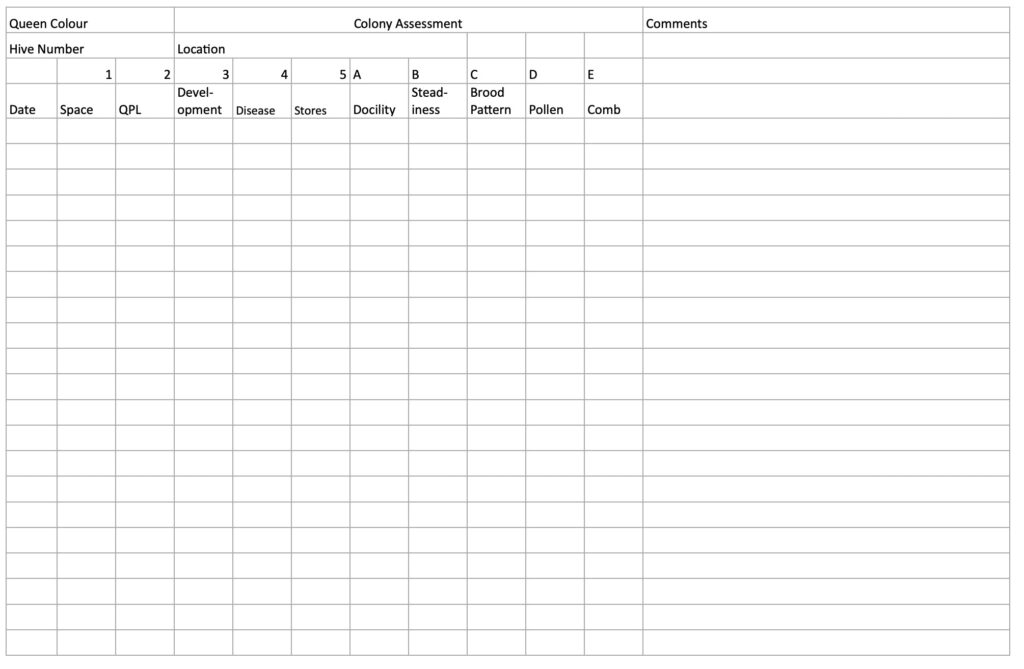Bee improvement is not difficult – anybody can do it and in fact every beekeeper should do it. The first step is to assess your colonies for a full season and record the data in a Colony Assessment Sheet. It will take a full season because the bees often do not show their true colours till they are big and strong and start to throw their weight about. Once you have the data you can compare colonies systematically and objectively then select stocks for breeding and stocks for culling.
The sheet below has been designed to record both Colony Assessment Data and routine beekeeping information from each visit. Click it for a better view. Scroll down and I’ll walk you through it…
Alternatively click here to download the same sheet in Excel format
Here goes:
It starts with boxes to record the queen colour (and number, if you number your queens), the hive number and the location.
The first 5 columns are to record the answers to Hooper’s five questions which guide the beekeeper through what he or she should be looking for on each visit – namely:
- Do the bees have enough space? This is important for swarm prevention and swarm control;
- Is the queen present and is she laying?
- How many frames contain brood?
- Is there any sign of disease?
- Do the bees have enough stores?
Click here for more on Hooper’s 5 questions
The next 7 columns headed A-G are based on Colony Assessment Criteria devised by the Galtee Bee Breeding Group and these are to assess the quality of each colony. Each trait is marked out of 5 with 5 being the highest mark and 0 the lowest with the exception of Chalkbrood which is an undesirable trait – if there is a lot of chalkbrood the mark is 0 and if there is none the mark is 5.
- Docility – are the bees nice and docile or do they want to kill you and your smoker?
- Steadiness – are the bees steady on the comb or are they running about;
- Brood pattern – is the brood pattern solid and unbroken or is it erratic or pepperpot? Pepperpot brood can be a sign of American Foul Brood OR inbreeding;
- Pollen – have the bees got lots of pollen? The urge to amass lots of pollen is a sign that the bees will overwinter well and can sustain themselves through long periods of foul weather;
- Comb building – do the bees draw beautiful even honey comb or is it ragged and abstract?
If you wish, you can add columns to record blackness and chalkbrood.
- Blackness – are the bees nice and black? There can be varying amounts of orange bees in amongst their black sisters. This is a mark of how many orange drones were involved in the mating of the queen and as such is a measure of interbreeding with non-native bees. If there is a high percentage of orange bees, the queens (however black they themselves might be and however pure their origins) should be culled before they begin to produce drones.
- Chalkbrood. A lot of chalkbrood is a sign that the bees do not have Hygienic Behaviour in their DNA and as such will be less likely to detect Varroa in sealed brood.
At the end of the season – the data from the assessment sheets can be analysed and the results tabulated for appraisal and comparison using a Colony Appraisal Sheet. Click here for more on Honey Bee Colony Appraisal.
Click here for How to Use this Stuff to Improve your Bees
Copyright © Beespoke.info, 2015. All Rights Reserved.

